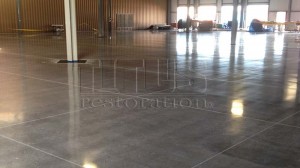Based on training and experience, every polished concrete contractor will perform polished concrete different. Here are some basic guidelines and understandings for how to polish concrete.
Steps to Polish Concrete Floors:
Scratch test
The scratch test or (MOHS Hardness test) tells us the hardness of the concrete and helps determine the correct diamond hardness of the concrete grinding tools to begin the first diamond polishing step.
Grinding to a hone
The first major noteworthy distinction we have is whether to wet grind or dry grind; when deciding how to polish concrete take this major health and safety factor into consideration. Titus performs its grinding wet for the sake of the health and well-being of our employees and our customers. This will be discussed extensively in this site and also through various channels, such as YouTube and social media, managed by us. The initial concrete grinding stages will be performed by progressively following the grit number of the diamonds, achieving refinement without leaving visible scratches.
-
Diamond Grinding Tools
The concrete polishing process is made possible by tooling that contain diamonds embedded in the resin, metal or ceramic matrix. There are may different types of diamond tools for different circumstances. They can differ in shape, pattern, lippage of the rim, hardness, and grit (size of diamond). It is important to know that starting from the appropriate grit and achieving an even scratch pattern, followed by the right sequence of refinement is the proper way to achieve great diamond polished concrete floors. The higher the final grit used, the finer the scratch pattern will be, resulting in a shinier finish. (Types of diamonds and their many differentiations will be treated in a separate case study, in the category “Diamonds grinding tools” in our blog.
Densification
Densifiers are distinguished first of all for their chemical basis. There are 3 main types of densifiers available: Potassium, Sodium and Lithium based. Titus only uses a proprietary lithium-based densifier. This lithium-based densifier penetrates into the concrete increasing surface density and helping to eliminate dust. This is commonly referred to as concrete floor sealing, but it is also used as part of the concrete floor polishing process.
Polishing
The concrete floor polishing stage is similar to concrete grinding process but uses finer diamond tools. Diamond tools used in this process may differ in the shape and material composition. Polishing occurs when the floor becomes more refined and begins to shine. When learning how to polish concrete, it is important to watch for scratches left in the floor during these steps.
Stain protection
Stain protection is an option based on the customers’ needs. Using Titus’ proprietary brand of lithium silicate, polymer enhanced stain protection will provide a surface that is resistant to stains while allowing the concrete to breathe.
Burnishing
If stain protection is right for the customer’s project, it will be burnished into the concrete at high temperatures using a diamond-impregnated pad. This makes the stain protection resistant to flaking or peeling and enhances the shine of the polished surface.
Other Relevant Topics:
- What is Polished Concrete
- Benefits of Polished Concrete
- Polished Concrete Maintenance
- Expectations and Possibilities of Polished Concrete
- Tips for the GC
- Polished Concrete Cost

